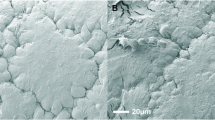Abstract
The degeneration process of lensfibres in a cataractous lens, described as the biochemical changes of a part of the lensproteins, can be characterised morphologically as follows: Emulsification of a part of the lensfibre-mass and the development of open spaces between the lensfibres with the formation of vacuoles (spherical structures) with a granular or a compact contents with high contrast, which is squeezed into the intercellular space. Degeneration of the ball & socket system interdigitation and microvilli domain system and the formation of almost empty rectangular structures in somewhat radial array. Balloon-like bulging of the cytoplasm of the lenscell, degeneration of the cytoplasm membrane and visualisation of a micro-filamentous network with enclosed cell organelles.
Similar content being viewed by others
References
Duncan G, Bushell AR. The bovine lens as an ion exchanger: A comparison with ion levels in human cataractous lenses. Exp Eye Res 1976; 23: 341–53.
Fagerholm PP. The influence of calcium on lensfibres. Exp Eye Res 1979; 28: 211–22.
Beyer-Mears A, Farnsworth PN. Diminished sugar cataractogenesis by quercetin. Exp Eye Res 1979; 28: 709–16.
Varma SD, Kinoshita JH. Inhibition of lens aldose reductase by flavonoids their possible role in the prevention of diabetic cataracts. Biochem Pharmacol 1976; 25: 2505–13.
Varma SD, Mizuno A, Kinoshita JH. Diabetic cataracts and flavonoids. Science 1977; 195: 205–6.
Racz P, Tompa K, Pocsik I. The state of water in normal and senile cataractous lenses studied by nuclear magnetic resonance. Exp Eye Res 1979; 28: 129–35.
Racz P, Tompa K, Pocsik I, Banki P. NMR spectroscopy of the ocular lens. Lens Res 1983; 1: 199–206.
Pirie A. Formation of N'Formylkynurenine in proteins from lens and other sources by exposure to sunlight. Biochem J 1971; 125: 203–8.
Harding JJ. Changes in lensproteins in cataract. In: Bloemendaal H, ed. The eye-lens as a tool for molecular and cellular sciences New York: John Wiley, 1980: 324–65.
Harding JJ. Possible causes of the unfolding of proteins in cataract and a new hypothesis to explain the high prevalence of cataract in some countries. In: Regnault F, Hockwin O, Courtois Y, eds. Aging of the lens Amsterdam: Elsevier, 1980: 71–80.
Jedziniak J, Kinoshita JH, Yates EM, Benedek GB. The concentration and localization of heavy molecular weight aggregates in aging normal and cataractous human lenses. Exp Eye Res 1975; 20: 367–69.
Kinoshita JH. Mechanisms initiating cataract formation. Invest Ophthalmol 1974; 13: 713–23.
Spector A, Stauffer J, Sigelman J. Preliminary observations upon proteins of the human lens. Ciba Foundation Symposium, ASP-Amsterdam, 1973; 19: 187–206.
Jongebloed WL, Kalicharan D, Los LI, Van der Veen G, Worst JGF. A combined scanning and transmission electron microscopic investigation of human (secondary) cataract material. Doc Ophthalmol 1991; 78: 325–34.
Jongebloed WL, Kalicharan D, Los LI, Worst JFG. A study of the substructure of the MORGAGNI and BRUNESCENS cataract with help of the TAO non-coating technique, Part 1 & 2. Doc Ophthalmol 1992; 82: 151–68.
Kalicharan D, Hulstaert CE, Hardonk MJ. Prevention of penetration hindrance in ceriumbased glucose-6-phosphatase, cytochemistry by freezing tissue in melting nitrogen. Histochemistry 1985; 82: 287–92.
Drenckhahn D. Polar cataract and lysosomal alterations in the lens of rats treated with amphilic lipodosis-inducing drugs chloroquinine and chlorphentermine. Virch Arch B Cell Path 1978; 27: 255–66.
Anderson RS, Shearer TR. Selenite nuclear cataractogenesis scanning electron microscope study. Current Eye Res 1992; 11: 1147–60.
Bettelheim A. Physical basis of lens transparency. In: Meisel, ed. The ocular lens structure, function and pathology. New York: Marcel Dekker, 1985: 265–300 (Chap. 7).
Author information
Authors and Affiliations
Rights and permissions
About this article
Cite this article
Kalicharan, D., Jongebloed, W.L. & Worst, J.G.F. Lensfibre degeneration at cataract lenses. Doc Ophthalmol 85, 77–85 (1993). https://doi.org/10.1007/BF01268103
Accepted:
Issue Date:
DOI: https://doi.org/10.1007/BF01268103




